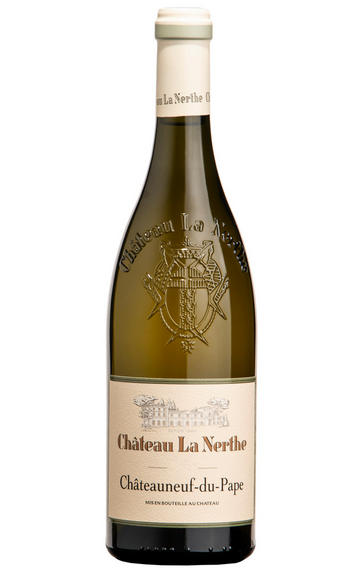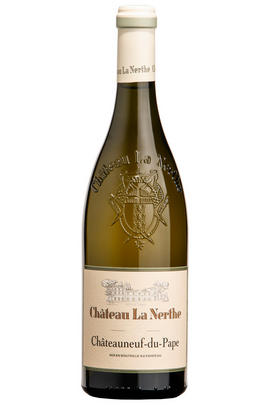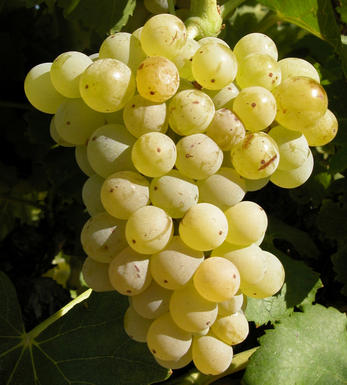
2020 Châteauneuf-du-Pape Blanc, Château La Nerthe, Rhône

Critics reviews
47% Roussanne, 38% Grenache Blanc, 13% Clairette, 2% Bourboulenc. Aged six months in tank (30%), demi-muid (30%) and new and old barrels (20% each).
Organic. Touch of reduction but blows away to reveal a more floral edge. Round and intense on the palate with impressive concentration of fruit. Oak present adding sweetness. Just sufficient freshness. Clearly has the capacity to age.
Drink 2023 - 2032
James Lawther MW, jancisrobinson.com (Dec 2021)
There are nutmeg and cedar touches to the restrained pear fruit here. Medium-bodied, elegant and refined on the palate, the oak is used with great skill to shape the wine, which is classically styled, precise and highly enjoyable. Organically grown across three lieux-dits: La Crau, La Nerthe and La Rigole. Matured in oak barrels of various sizes and aged for six months, including 20% new oak.
Drink 2022 - 2028
Matt Walls, Decanter.com (Oct 2021)
Lightly hued, with more subtle yet classy notes of lemon curd, spice, and sappy green herbs, the 2020 Châteauneuf Du Pape Blanc is medium-bodied and has a layered, perfectly balanced mouthfeel, bright acidity, and a great finish. Give bottles another year in bottle to develop additional complexity and it will evolve nicely for over a decade. The blend is 47% Roussanne, 38% Grenache Blanc, and the balance Clairette and Bourboulenc.
Drink 2023 - 2033
Jeb Dunnuck, jebdunnuck.com (Nov 2021)
About this WINE

Chateau la Nerthe
Château la Nerthe is a stunning, 500-year-old property becoming ‘one to watch’ in recent years. Working organically since 1998, its 57 parcels on various soils and expositions produce a seamless, complex Châteauneuf-du-Pape. The care taken in both vineyard and cellar has resulted in seriously impressive wines. This property is, absolutely, a worthy rival to the likes of Château de Beaucastel. Winemaker Rémi Jean is as inspiring as the terroir – his understanding of the multiple plots and attention to detail is impressive.
Château la Nerthe’s remarkable terroir produces beautiful wines, year-in, year-out. Rocky, clay and sandy soils combined with natural springs imbue the wines with wonderful freshness and minerality. Rémi says Grenache gives his red blends “magic”, Mourvèdre brings complexity and Syrah provides structure. The very special top white cuvée, Clos de Beauvenir, comes from a single, walled plot: an old castle garden in front of the historic château.

Châteauneuf-du-Pape
The most celebrated village of the Southern Rhône, Châteauneuf-du-Pape is the birthplace of the now indispensable French Appellation d’Origine Contrôlée system – imperfect though it may be. Compared to the Northern Rhône, the vineyards here are relatively flat and often feature the iconic galet pebbles – the precise benefits of which are a source of much debate. Minimum alcohol levels required by the AOC are the highest in France, but at 12.5% it is well below the natural generosity of Grenache, which only achieves its full aromatic potential when it is fully ripe and laden with the resultant high sugars. Syrah and Mourvèdre contribute the other defining elements in the blend, adding pepper, savoury spice and structure to the decadent Grenache. There are a further 10 permitted red grape varieties which can be used to adjust the “seasoning”. Of the five white varieties permitted, it is Grenache Noir’s sibling – predictably perhaps – Grenache Blanc, which dominates, though Roussanne shows a great deal of promise when handled well, notably at Château de Beaucastel.

White Rhône Blend
With the exception of the wines from Condrieu and Château-Grillet virtually all Rhône Valley whites are made from blends.
In the north, the white wines of Hermitage, Crozes-Hermitage, St-Joseph, and St-Péray are produced from blends of Marsanne and Roussanne. Generally Marsanne is the dominant partner and it lends colour, body and weight to the blend, as well as richly scented fruit. Roussanne, a notoriously low yielder and pernickety to grow, produces intensely aromatic wines which contribute bouquet, delicacy and finesse to the blend.
Until about 15 years ago there was very little interest in southern Rhône whites as it was widely believed that the combination of dull non aromatic grapes and the baking summer heat meant quality wine production was nigh impossible. Since then the quality has improved markedly through the introduction of cool fermentation techniques and increased plantings of northern Rhône white grapes.
The base of many blends is still Grenache Blanc, a widely planted variety producing fresh wines with apple-like fruits, often with hints of aniseed. Ugni Blanc is still found in many blends, as is Clairette though their general lack of character and definition has led to a reduction in plantings. The future for southern Rhône whites appears to lie with Roussanne, Marsanne, and, increasingly, Viognier.


Buying options
Add to wishlist
Description
Made from 50% Roussanne, 38% Grenache and 12% Clairette, this beautiful white wine has an open, generous nose of peach, yellow apple and crème anglaise. It has a toasty backbone but the wine is very fresh with a lovely gliding texture. It is smooth and creamy and quite delicious. There is no need to rush this wine, it is very giving and incredibly rewarding. Drink 2022-2028.
wine at a glance
Delivery and quality guarantee